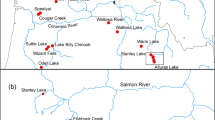Abstract
Using Parensky's approach for estimating the number of breeding pairs, we determined effective subpopulation size N e in early-run sockeye salmon Oncorhynchus nerka from Azabach'e Lake (Kamchatka) in 1977 through 1981. On average (over years and populations), biased sex ratio decreased N e by 7% as compared to the number of fish on the spawning sites (N i). High density reduced the N e /N i ratio by 62–66% because some fish were excluded from spawning. Dominance polygyny as compared to monogamy and random union of gametes could reduce N e by about 17%.
Similar content being viewed by others
REFERENCES
Wright, S., Evolution in Mendelian Populations, Genetics, 1931, vol. 16, pp. 97-159.
Caballero, A., Developments in the Prediction of Effective Population Size, Heredity, 1994, vol. 73, pp. 657-679.
Waples, R., A Generalized Approach for Estimating Effective Population Size from Temporal Changes in Allele Frequency, Genetics, 1989, vol. 121, pp. 379-391.
Turner, T.F., Richardson, L.R., and Gold, J.R., Temporal Genetic Variation of Mitochondrial DNA and the Female Effective Population Size of Red Drum (Sciaenops ocellatus) in the Northern Gulf of Mexico, Mol. Ecol., 1999, vol. 8, pp. 1223-1229.
Crow, J.F. and Kimura, M., An Introduction to Population Genetics Theory, New York: Harper and Row, 1970.
Wright, S., Size of Population and Breeding Structure in Relation to Evolution, Science, 1938, vol. 87, pp. 430-431.
Hill, W.G., Effective Size of Populations with Overlapping Generations, Theor. Populat. Biol., 1972, vol. 3, pp. 278-289.
Hill, W.G., A Note on Effective Population Size with Overlapping Generations, Genetics, 1979, vol. 92, pp. 317-322.
Simon, R.C., McIntyre, J.D., and Hemingsen, A.R., Family Size and Effective Population Size in a Hatchery Stock of Coho Salmon (Oncorhynchus kisutch), Can. J. Fish. Aquat. Sci., 1986, vol. 43, pp. 2434-2442.
Geiger, H.J., Smoker, W.W., Zhivotovsky, L.A., and Gharrett, A.J., Variability of Family Size and Marine Survival in Pink Salmon (Oncorhynchus gorbuscha) Has Implications for Conservation Biology and Human Use, Can. J. Fish. Aquat. Sci., 1997, vol. 57, pp. 2368-2373.
Hedrick, P.W., Rashbrook, V.K., and Hedgecock, D., Effective Population Size of Winter-Run Chinook Salmon Based on Microsatellite Analysis of Returning Spawners, Can. J. Fish. Aquat. Sci., 2000, vol. 57, pp. 2368-2373.
Nunney, L., The Influence of Mating System and Overlapping Generations on Effective Population Size, Evolution, 1993, vol. 47, pp. 1329-1341.
Nunney, L. and Elam, D.R., Estimating the Effective Population Size of Conserved Populations, Conserv. Biol., 1994, vol. 8, pp. 175-184.
Bouteiller, C. and Perrin, N., Individual Reproductive Success and Effective Population Size in the Greater White-Toothed Shrew Crocidura russula, Proc. R. Soc. London, B, 2000, vol. 267, pp. 701-705.
Altukhov, Yu.P., Salmenkova, E.A., and Omel'chenko, V.T., Populyatsionnaya genetika lososevykh ryb (Population Genetics of Salmonids), Moscow: Nauka, 1997.
Parenskii, V.A., Efficiency of the Use of Spawning Grounds by Red Salmon Oncorhynchus nerka Spawners, Biol. Morya, 1997, no. 4, pp. 234-238.
Konovalov, S.M., Populyatsionnaya biologiya tikhookeanskikh lososei (Population Biology of Pacific Salmon), Leningrad: Nauka, 1980.
Author information
Authors and Affiliations
Rights and permissions
About this article
Cite this article
Efremov, V.V., Parensky, V.A. Effective Size of Subpopulations in Early-Run Sockeye Salmon Oncorhynchus nerkafrom Azabach'e Lake (Kamchatka): The Effect of Density on Variance of Reproductive Success. Russian Journal of Genetics 40, 431–436 (2004). https://doi.org/10.1023/B:RUGE.0000024981.15293.00
Issue Date:
DOI: https://doi.org/10.1023/B:RUGE.0000024981.15293.00




